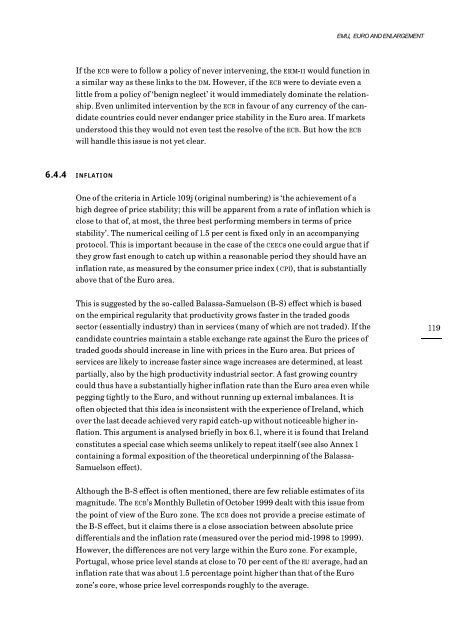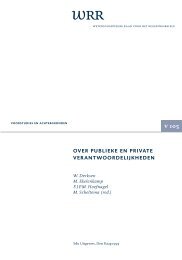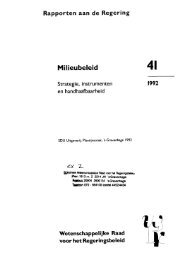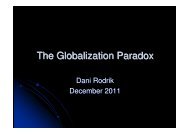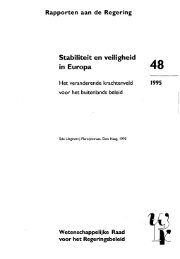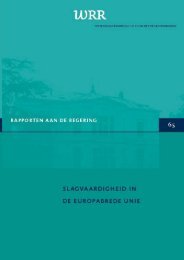w 109 long-run economic aspects of the european union's eastern ...
w 109 long-run economic aspects of the european union's eastern ...
w 109 long-run economic aspects of the european union's eastern ...
Create successful ePaper yourself
Turn your PDF publications into a flip-book with our unique Google optimized e-Paper software.
EMU, EURO AND ENLARGEMENTIf <strong>the</strong> ECB were to follow a policy <strong>of</strong> never intervening, <strong>the</strong> ERM-II would function ina similar way as <strong>the</strong>se links to <strong>the</strong> DM. However, if <strong>the</strong> ECB were to deviate even alittle from a policy <strong>of</strong> ‘benign neglect’ it would immediately dominate <strong>the</strong> relationship.Even unlimited intervention by <strong>the</strong> ECB in favour <strong>of</strong> any currency <strong>of</strong> <strong>the</strong> candidatecountries could never endanger price stability in <strong>the</strong> Euro area. If marketsunderstood this <strong>the</strong>y would not even test <strong>the</strong> resolve <strong>of</strong> <strong>the</strong> ECB. But how <strong>the</strong> ECBwill handle this issue is not yet clear.6.4.4 INFLATIONOne <strong>of</strong> <strong>the</strong> criteria in Article <strong>109</strong>j (original numbering) is ‘<strong>the</strong> achievement <strong>of</strong> ahigh degree <strong>of</strong> price stability; this will be apparent from a rate <strong>of</strong> inflation which isclose to that <strong>of</strong>, at most, <strong>the</strong> three best performing members in terms <strong>of</strong> pricestability’. The numerical ceiling <strong>of</strong> 1.5 per cent is fixed only in an accompanyingprotocol. This is important because in <strong>the</strong> case <strong>of</strong> <strong>the</strong> CEECs one could argue that if<strong>the</strong>y grow fast enough to catch up within a reasonable period <strong>the</strong>y should have aninflation rate, as measured by <strong>the</strong> consumer price index (CPI), that is substantiallyabove that <strong>of</strong> <strong>the</strong> Euro area.This is suggested by <strong>the</strong> so-called Balassa-Samuelson (B-S) effect which is basedon <strong>the</strong> empirical regularity that productivity grows faster in <strong>the</strong> traded goodssector (essentially industry) than in services (many <strong>of</strong> which are not traded). If <strong>the</strong>candidate countries maintain a stable exchange rate against <strong>the</strong> Euro <strong>the</strong> prices <strong>of</strong>traded goods should increase in line with prices in <strong>the</strong> Euro area. But prices <strong>of</strong>services are likely to increase faster since wage increases are determined, at leastpartially, also by <strong>the</strong> high productivity industrial sector. A fast growing countrycould thus have a substantially higher inflation rate than <strong>the</strong> Euro area even whilepegging tightly to <strong>the</strong> Euro, and without <strong>run</strong>ning up external imbalances. It is<strong>of</strong>ten objected that this idea is inconsistent with <strong>the</strong> experience <strong>of</strong> Ireland, whichover <strong>the</strong> last decade achieved very rapid catch-up without noticeable higher inflation.This argument is analysed briefly in box 6.1, where it is found that Irelandconstitutes a special case which seems unlikely to repeat itself (see also Annex 1containing a formal exposition <strong>of</strong> <strong>the</strong> <strong>the</strong>oretical underpinning <strong>of</strong> <strong>the</strong> Balassa-Samuelson effect).119Although <strong>the</strong> B-S effect is <strong>of</strong>ten mentioned, <strong>the</strong>re are few reliable estimates <strong>of</strong> itsmagnitude. The ECB’s Monthly Bulletin <strong>of</strong> October 1999 dealt with this issue from<strong>the</strong> point <strong>of</strong> view <strong>of</strong> <strong>the</strong> Euro zone. The ECB does not provide a precise estimate <strong>of</strong><strong>the</strong> B-S effect, but it claims <strong>the</strong>re is a close association between absolute pricedifferentials and <strong>the</strong> inflation rate (measured over <strong>the</strong> period mid-1998 to 1999).However, <strong>the</strong> differences are not very large within <strong>the</strong> Euro zone. For example,Portugal, whose price level stands at close to 70 per cent <strong>of</strong> <strong>the</strong> EU average, had aninflation rate that was about 1.5 percentage point higher than that <strong>of</strong> <strong>the</strong> Eurozone’s core, whose price level corresponds roughly to <strong>the</strong> average.


